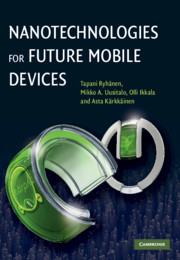Book contents
- Frontmatter
- Contents
- List of contributors
- Preface
- 1 When everything is connected
- 2 On the possible developments for the structural materials relevant for future mobile devices
- 3 Energy and power
- 4 Computing and information storage solutions
- 5 Sensing, actuation, and interaction
- 6 Future of Radio and Communication
- 7 Flat panel displays
- 8 Manufacturing and open innovation
- 9 Seeing beyond the hype: what the Internet teaches us about the development of nanotechnology
- 10 Conclusions
- Index
- References
2 - On the possible developments for the structural materials relevant for future mobile devices
Published online by Cambridge University Press: 05 July 2014
- Frontmatter
- Contents
- List of contributors
- Preface
- 1 When everything is connected
- 2 On the possible developments for the structural materials relevant for future mobile devices
- 3 Energy and power
- 4 Computing and information storage solutions
- 5 Sensing, actuation, and interaction
- 6 Future of Radio and Communication
- 7 Flat panel displays
- 8 Manufacturing and open innovation
- 9 Seeing beyond the hype: what the Internet teaches us about the development of nanotechnology
- 10 Conclusions
- Index
- References
Summary
Materials science and processing technologies of electronics materials have been central to the rapid progress that we have experienced in electronics and its applications. Drastically new options are being realized and these can have a major impact on mobile devices, based on applications related to, e.g., flexible and polymer electronics and roll-to-roll processes. Mobile devices are, however, balanced combinations of electronics and peripheral structures, in which the latter are also strongly dependent on the advanced materials that are available. There is expected to be relevant progress in materials science contributing to the structural parts of mobile devices, e.g., promoting lightweight construction, rigidity, flexibility, adaptability, functional materials, sensing, dirt repellency, adhesive properties, and other surface properties. In this chapter we will review some of the potential future developments, leaving some others to be discussed in later chapters since they are intimately related to the developments of the electronics. We expect the most significant developments to take place in “soft” organic and polymeric materials and nanostructured organic-inorganic hybrids and therefore the main emphasis is there. Biological materials offer illustrative examples of advanced materials properties providing versatile lightweight, functional, and sustainable structures, showing potential for the design of novel materials.
Introduction
It is expected that new multifunctional materials with specific combinations of properties will extensively be developed for the structural parts and user interfaces of future mobile devices. Adaptivity, sensing, and context awareness are key sought-after features, and are described widely in the different chapters of this book.
Information
- Type
- Chapter
- Information
- Nanotechnologies for Future Mobile Devices , pp. 21 - 50Publisher: Cambridge University PressPrint publication year: 2010
References
Accessibility standard: Unknown
Why this information is here
This section outlines the accessibility features of this content - including support for screen readers, full keyboard navigation and high-contrast display options. This may not be relevant for you.Accessibility Information
- 1
- Cited by
